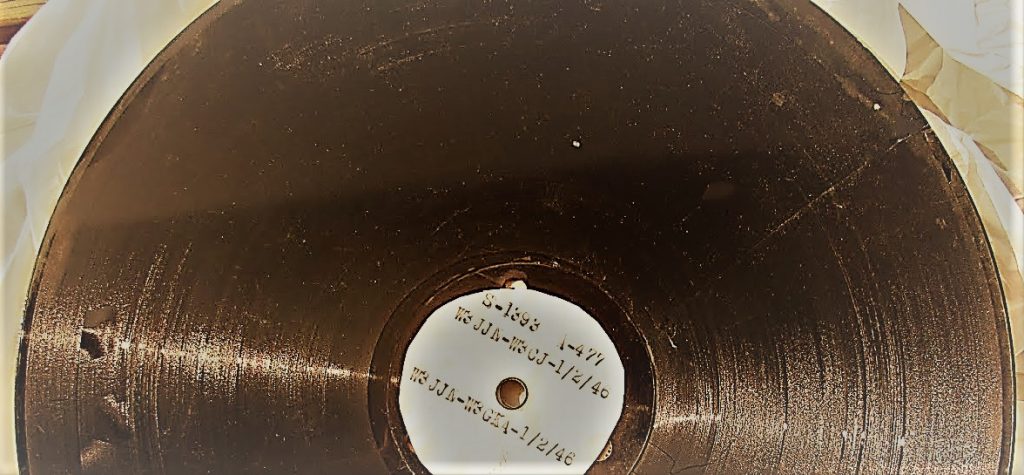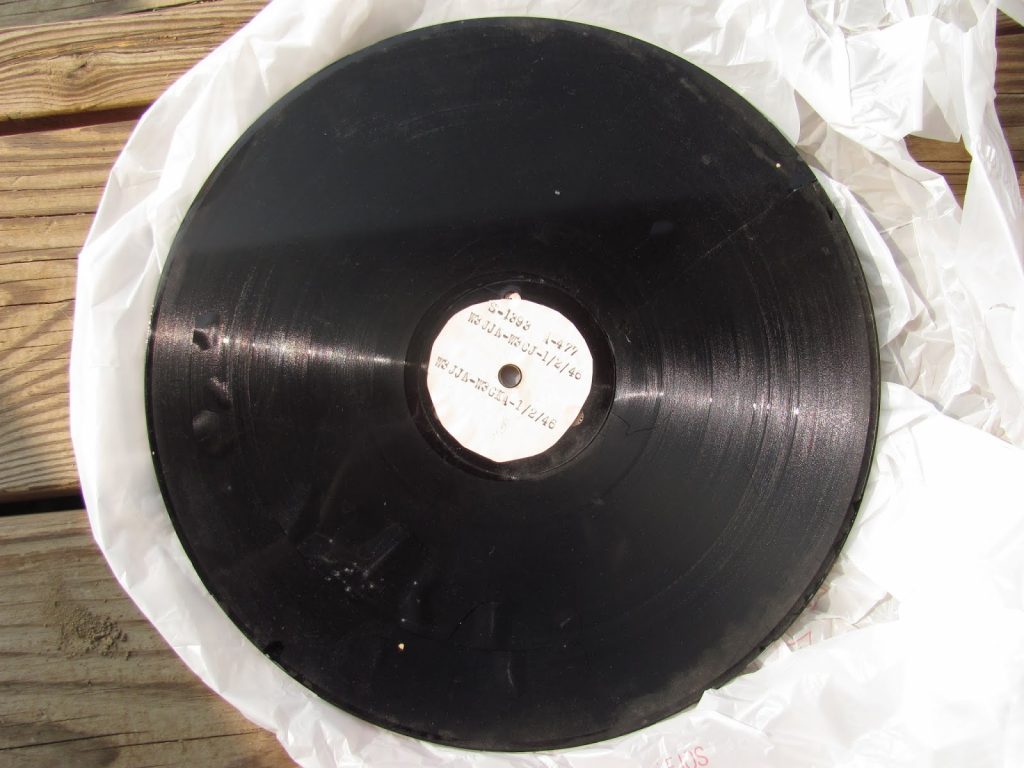At the Winter SWL Fest last week, my friend, Andrew Yoder (author of the Pirate Radio Annual) told me about a recent find: homemade records by amateur radio operator W3JJN.
Andrew wrote about these recordings on his blog:
[…]Before open-reel decks were wire recorders. Information was magnetized onto a fine reel of stainless steel wire. It was essentially the same concept as tape decks, whether open reel or cassette, only the tape system was a refinement (an oxide coating on a plastic tape), rather than trying to magnetize a wire.
[…]Before wire recorders were record recorders. These took an audio source and the needle cut a blank disc with grooves. From what I understand, these homemade discs weren’t meant to be played back too many times because the needles wore into the grooves more quickly than commercially manufactured records. I’m not sure what they were all made from, but I know that some were aluminum discs with a thin layer of plastic.
I always look for the homemade records because there weren’t too many options for audio sources back then. By the open-reel tape era, a lot of people were recording entire albums to tape, so they weren’t necessarily recording the radio. But, for example, in 1940, the options were basically either family greetings, someone singing or a band playing, or the radio. And chances are good that any recording you find is the only one in existence.
I found three of these on Saturday.
Here’s a photo of one.
They are amateur radio QSOs from W3JJN to a couple of other operators. W3JJN cataloged the discs by side . . . and this was number 477. So, at least 237 other records existed in his homemade record collection at one time. The sides that I have are dated in late 1945 and early 1946. To me, this is an astounding find because I’m not sure how many recordings exist of any amateur radio operations prior to 1950, not to mention that this is still very early in the post-war period.
I did some searching on W3JJN and he was William E. Belz, who lived at that time on 1509 Linden Avenue in Baltimore, Maryland. He was a TV repairman who was born in Duncansville, PA, and died in 1981 after a lengthy illness.
My big problem here is that these records are disintegrating. The plastic layer is cracking badly and separating from the aluminum discs. I guess what I really need is one of the laser turntables that can play back audio from broken discs and won’t damage the grooves. I don’t think I can risk playing any of these on a regular turntable, but I want to recover the audio quickly before the discs degrade further.
Post readers: Any advice on preserving these recordings? It sounds like using an actual needle to make a digital copy might be a little too destructive. Are there alternatives? Please comment if you have any experience or suggestions!



I have similar homemade records from the 1940’s. I have been hanging onto them for decades wanting to restore them but not quite knowing how.
I recently realized AI technology is available to the public through various websites and through the freeware program UVR5. (Ultimate Vocal Remover). I used my nice turntable to record the 78rpm discs onto CD with a CD recorder at 33rpm. Then I used Audacity to change the speed from 33 to 78. Then UVR5 to restore the recordings themselves.
I can’t imagine I’ll ever need to play them again. Recording them at slower speed helped the needle hold the groove without jumping or skipping. Some of the results have been revelatory, and in some cases the records were degraded so bad you still can’t make out what is being said, but can at least clearly hear tone of voice – like they are talking in another room.
My process worked out well for me. Good luck with your own records!
Mark, my mother recently passed at 97 and as we went through her home we found many treasures one of which is a vintage 1940s Soundcraft recording. The record sleeve was marked with my father‘s name and”Speech I Tu & Th.” It seems to be a Recording of my dad for his speech class (he went to college on the GI bill after WWII).
I am so thrilled at the thought that I may be able to hear his voice again 15 years after he died, and 70 something years after he recorded it.
Just wanted to let you know that your post has given me some tips about how to proceed to search out what I need.. And to say thank you!
I don’t knowif this is a good place to get an answer to a big problem that has botheted me for years
When I was a child in the 1940’s mydad had a radio with a record plaýer that also made records, from the radio or live thru a microphone.
There are recordings of long gone family that i. Want to preserve.
The problem is these recordings were made from the inside to the outside snd I just don’t know where or how to play them
If you have ANY suggestions I would be very thankful
Also i am notvery tech knowledgablle so could you please answer on my email
Gratefully yours
[email protected]
If you can’t access a laser turntable, the best you can do is to transfer the parts of the discs that are still intact. I wouldn’t clean them with any kind of liquid – that will just make the lacquer layer more unstable if there’s cracking already.
One thing I’ve done, for discs where the cracks are there, but pieces haven’t fallen off yet, is to transfer the discs at half speed – than can help where a crack can cause skipping and instability at a higher speed like 78 rpm.
I’d recommend getting these to someone with the right styli and equipment to transfer them asap – there’s no stopping the disintegration of the sides once it’s started.
Maybe this might be the solution:
http://www.audio-restorations.com/homemade_records/
Expensive but probably less than what it would cost if you DIY.
I doubt that a service like that may be appropriate, given the fact that, as Thomas wrote, those records are literally “falling apart”, the very simple operation of “washing” them, as described at the link you posted would result in a totally destroyed record out of any hope to recover the audio.
I think that the only way to attempt recovering the contents of those records would be using a “laser turntable” (https://en.wikipedia.org/wiki/Laser_turntable) or either the IRENE system (see previous link); the problem is that both systems aren’t cheap, so I think that a first attempt may be trying to contact some large “archiving” entity (e.g. the Smithsonian or the like) to find out if they may help in reading those recordings and convert them to digital format; in such a case it would be advisable to use an uncompressed format (or a lossless compression method) to obtain the original tracks which may then be post processed, cleaned and converted to some (lossy) compressed format like MP3
HTH